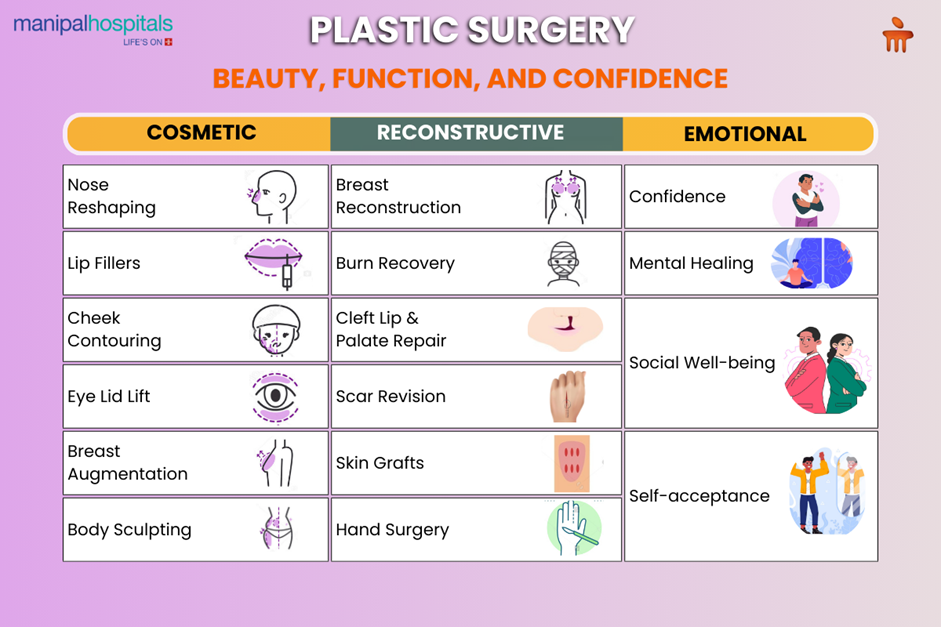
Plastic surgery focuses on restoring function and appearance through cosmetic and reconstructive procedures. While often linked to aesthetics, its core purpose is to help patients regain normalcy, confidence, and daily function after injury, illness, or deformity. It allows patients to regain their pride and human dignity and maintain standard daily activities following life-changing events.
Synopsis
Beyond Beauty: Restoring Confidence, Dignity, and Normalcy
Plastic surgery goes beyond aesthetics; it is often the key to restoring dignity and confidence, helping patients regain a sense of normalcy after difficult life events. A top plastic surgeon in Yeshwanthpur, Bangalore, lists out some examples of how reconstructive surgery helps restore these essential elements of life:

-
Correcting Congenital Conditions: Cleft lip and palate repair, among other congenital procedures, helps patients regain both physical capabilities and restore oral functionality, with improved speech-feeding abilities and altered appearance at early childhood stages.
-
Post-Cancer Reconstructive Support: Cancer surgeries might require the removal of a significant amount of body tissues, sometimes including a part of an organ or an entire organ. These surgeries followed up by reconstructive surgeries can help restore the aesthetics of the excised organ. For instance, breast reconstruction after mastectomy helps restore a woman’s physical form and supports emotional healing following cancer treatment. It plays a key role in improving body image and psychological recovery.
-
Burn and Trauma Recovery: Skin grafts and flap surgeries, which are used to treat burn victims, enhance their physical recovery by restoring function and emotional recovery through better body appearance.
-
Facial Reconstructive Surgeries: Facial reconstructive procedures restore identity and social self-confidence to people who have sustained facial disfigurements from medical illnesses or injuries.
The Deeper Impact of Trauma Recovery
Reconstructive surgery not only heals the body but also plays a crucial role in emotional recovery, helping trauma survivors rebuild their lives. Below are the key ways these surgeries help patients overcome emotional and psychological challenges:
-
Psychological Healing Through Physical Restoration: Reconstructive surgeries address disfigurement that can cause deep emotional trauma, helping patients reclaim self-esteem and social confidence.
-
Restoring a Sense of Normal Life: Trauma patients often struggle with loss of normalcy – surgical correction helps them reintegrate into daily routines and relationships.
-
Empowering Survivors to Move Forward: By correcting visible injuries, surgery enables survivors to detach from painful experiences and focus on healing emotionally.
-
Minimising Social Stigma: Visible deformities can attract stigma – surgical improvements reduce discrimination and enhance social acceptance.
Patient Perspectives: Emotional and Social Impact of Reconstructive Surgery
The emotional and social effects of reconstructive surgery are profound, with patients sharing stories of empowerment, healing, and renewal. Here are some patient perspectives:
-
Burn Survivors Regaining Identity: Survivors often describe surgery as life-changing - restoring their ability to engage confidently in social and professional settings.
-
Cleft Palate Corrections and Communication: Children and adults benefit from improved speech and social interactions, reducing bullying and communication barriers.
-
Post-Cancer Empowerment Stories: Patients share how reconstructive breast surgery helped them emotionally close a difficult chapter and feel whole again.
-
Accident Recovery and Self-Esteem: For road accident victims, facial and limb reconstruction helps restore confidence and overcome trauma-linked depression.
The Role of Innovation
Innovation is transforming the field of plastic surgery, improving outcomes and accessibility for patients. Below are some examples of how cutting-edge techniques are making a difference in reconstructive surgery:
-
Advanced Microsurgery Techniques: Microsurgical methods enable precise nerve and tissue repair, improving functional and aesthetic outcomes.
-
3D Imaging and Surgical Planning: Custom 3D models allow surgeons to visualise and plan procedures with incredible accuracy for better results.
-
Minimally Invasive Options: New techniques reduce scarring, pain, and recovery time, making surgery more accessible and less intimidating.
-
Biomaterials and Regenerative Techniques: Tissue scaffolds and stem cell use enable better graft integration and natural healing in complex reconstructions.
Restoring Function
Plastic and reconstructive surgeries do more than enhance appearance—they play a crucial role in restoring function and improving the quality of life. From hand surgeries that bring back dexterity to skin grafts that heal deep wounds, these procedures enable individuals to regain their independence and confidence.
Here are ways in which reconstructive surgeries help restore function:
-
Hand Surgeries: Procedures such as tendon repairs or joint replacements restore hand mobility, allowing patients to regain the ability to perform daily tasks like eating, writing, or driving.
-
Skin Grafts: Skin grafts help heal large wounds or burns, restoring the skin's protective barrier and improving mobility, especially in areas like the face or hands.
-
Breast Reconstruction: After mastectomy, breast reconstruction helps women regain body confidence and functionality, contributing to emotional recovery and a sense of normalcy.
-
Facial Reconstruction: Surgery to repair facial injuries or congenital deformities improves not only appearance but also restores essential functions like speaking, eating, and breathing.
-
Limb Salvage Surgery: In cases of trauma or disease, surgeries that save limbs, such as reattaching severed limbs or repairing nerve damage, help patients regain independence and mobility.
Conclusion
Plastic and reconstructive surgery goes beyond medical procedures, offering healing and transformation. It restores identity, whether after an accident, cancer, or birth defects. With advancements in technology and compassionate care, it continues to change lives.
FAQ's
No. It also helps individuals with congenital disabilities, developmental abnormalities, and functional impairments due to various conditions.
Most reconstructive procedures that are medically necessary are covered by health insurance. Cosmetic procedures usually are not.
Cosmetic surgery is elective and enhances appearance. Reconstructive surgery is medically necessary and restores function or form.
It varies depending on the procedure, but most patients resume basic activities within a few weeks with proper post-op care.
Absolutely. After their procedures, many patients report improved mental health, confidence, and social reintegration.





















 5 Min Read
5 Min Read


.png)










